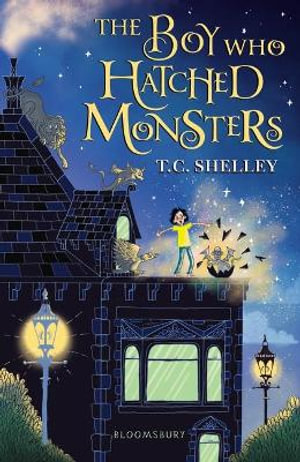The boy who hatched monsters by T.C. Shelley

The boy who hatched monsters is the third in The Imp Child trilogy written by WA author and teacher T.C. Shelley. These books spring from such a fertile and rich imaginative world that it is recommended that they are read in order, starting with The Monster who wasn't and Werewolves who weren't. Beginning with the third means that too much of the complicated character and plot evolution is missed leaving too many gaps for the reader to be able to fill in. The trilogy is recommended. It is a complicated but satisfying read.
There are many characters in these books. In fact, it seems, the whole of "monsterkind' inhabits these pages. There are leprechauns, pixies, trolls, boggarts, imps, banshees, brownies, goblins, trolls, ogres and more. The kingdom they inhabit is "The Hole"- a deep cavern which is the hub of the monster's lair deep under the earth's surface but accessible through street drain holes. At street level are the humans. We meet Russell who lives on the streets and his dog Kylie who first warns our hero Sam of the danger of Maggie an ancient Banshee who is hunting him down. Sam lives in the Kavanagh household with his "parents" Michelle and Richard. Sam is half monster/half fairy. He spends much of his time on the roof of the house at Brighton Beach. The house must be a magnificent old house because on its roof are gargoyles and if you didn't know it before - gargoyles are living creatures - of a sort! They are Sam's friends along with Daniel, the angel and a dove Yonah, so another layer of heavenly characters are added into the mix.
Monsters can only be produced by the evil ogre King Thunderguts who sighs beads into being. As sighs are made of regrets, fears and sadness, the beings produced are bad. Sam has produced a being through a sneeze and Queen Maggie wants him to produce an army of wicked ogres. When Sam refuses, Maggie wreaks sinister and vicious vengeance in the style of The Pied Piper of Hamelin on the children of Brighton and Hove. Outright warfare breaks out and it's bloodthirsty and violent.
The boy who hatched monsters, even more fanciful and populated by even more fantastic creatures than C.S Lewis's The lion, the witch and the wardrobe, nevertheless is reminiscent of the latter. The ending is climactic and mirrors, in a way, the rising of Aslan, although it is far more direct and not in the least reliant on symbolism. This makes the book (and the series) very powerful in its conception and unusual in the current literary environment because of its recognition of Christianity.
The foreword of the book contains a section from The Odyssey, Book X11, attrib. Homer, translated by Solomon Jedidiah (1865) about the Sirens. This reference sets the tone for the monsterlife that emerges from the pages of The boy who hatched monsters to be battled and changed for the better. Some very deep and important humanitarian themes arise.
You will never fail to notice gargoyles on a roof again and you will be looking out for monsters after reading The boy who hatched monsters.
Themes: Magical, Mythical creatures, Humans, The soul, Good and evil, Belonging, Leadership.
Wendy Jeffrey